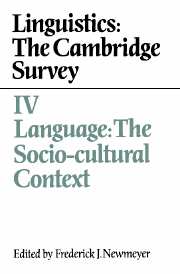Book contents
- Frontmatter
- Contents
- Contributors
- Preface
- 1 The study of language in its socio-cultural context
- 2 Language, culture, and world-view
- 3 Language and social class
- 4 Language and race: some implications for linguistic science
- 5 Language and gender
- 6 Bilingualism
- 7 Dialectology
- 8 Sociolinguistics and syntactic variation
- 9 Language birth: the processes of pidginization and creolization
- 10 Language death
- 11 Language planning: the view from linguistics
- 12 Ethnography of speaking: toward a linguistics of the praxis
- 13 The organization of discourse
- 14 Conversation analysis
- Index of names
- Index of subjects
- Contents of Volumes I, II, and III
11 - Language planning: the view from linguistics
Published online by Cambridge University Press: 05 June 2012
- Frontmatter
- Contents
- Contributors
- Preface
- 1 The study of language in its socio-cultural context
- 2 Language, culture, and world-view
- 3 Language and social class
- 4 Language and race: some implications for linguistic science
- 5 Language and gender
- 6 Bilingualism
- 7 Dialectology
- 8 Sociolinguistics and syntactic variation
- 9 Language birth: the processes of pidginization and creolization
- 10 Language death
- 11 Language planning: the view from linguistics
- 12 Ethnography of speaking: toward a linguistics of the praxis
- 13 The organization of discourse
- 14 Conversation analysis
- Index of names
- Index of subjects
- Contents of Volumes I, II, and III
Summary
Introduction
Languages offer their speakers a rich array of expressive possibilities. In a given situation, speakers ‘choose their words’ carefully in an attempt to communicate as closely as possible what they want others to understand. On a variety of levels (referential, emotive, social), these choices convey meaning. In English, for example, we say ‘lemme’ when we assess the situation as less formal, ‘let me’ when more formal; we indicate sarcasm with a particular intonation pattern; we demonstrate the relationship we perceive with an interlocutor by the form of address we use (Ms Jones, Susan, or a nickname). When distinct varieties of language, or different languages, are available within a community's linguistic repertoire, the resources for expression are increased still further, since the use of one language variety rather than another in a given situation conveys meaning as well, by demonstrating identification with a particular group, loyalty to a heritage language, attitude toward an interlocutor, and so on.
Since language alternatives typically carry social import, it is not surprising that attempts are made to influence the way in which language is used. As Fasold (1984: 246) observes, ‘The existence of alternatives makes planning possible.’ These alternatives exist at all levels of language use, but not all levels are equally susceptible targets for language planning.
- Type
- Chapter
- Information
- Linguistics: The Cambridge Survey , pp. 193 - 209Publisher: Cambridge University PressPrint publication year: 1988
- 7
- Cited by



